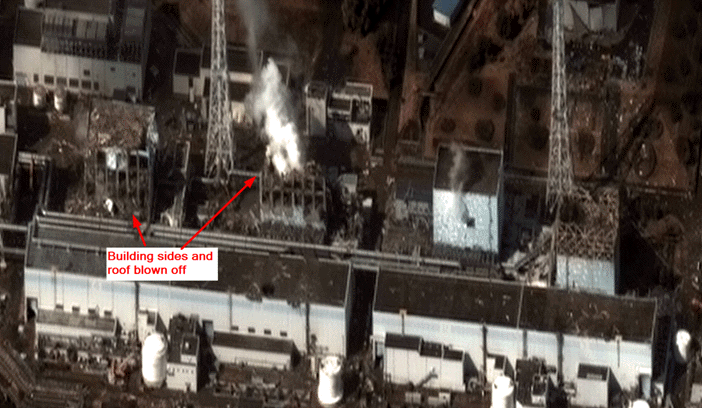PrudentSquirrel.com
16 March 2011
As I speak, they just tried to use helicopters to drop water on the reactors and the spent fuel rod storage. It was just cancelled due to high radiation…does this remind you of another disaster?? Beginning with a C and in Russia?
If Japan cannot control the situation at the reactors, they ultimately could spread a big fallout cloud across half of Japan. Reports out that some minute contamination appeared in a city over 50 miles away in the tap water.
We have maybe one week left or even days before a total evacuation of that area if things don't improve quickly. But take a look at this picture of the reactor areas and you tell me if it looks workable for emergency workers:

They have a mere 50 workers trying to control 6 damaged reactors. It is not working so far. Each reactor normally has 100 workers. They have pulled back. If the many stored spent fuel rods burn, they already had one storage pool catch fire of these, it can release enough radiation in the atmosphere to make it worse than Chernobyl. It would definitely result in millions of evacuees. Get this, the storage pools for the spent rods are stored OVER the reactors! And the bulding roofs blew off!
After the disaster, the commodity complex got hammered; even so the Japanese stocks rallied 6 % last night. Gold sold off hard and this is typical in any major market crash as people sell gold to cover margins.
Reversal of Yen carry trade
But, importantly, is a repatriation of Japanese money from abroad and also out of markets and the Yen carry trade. Considering how huge the Yen carry trade is, and that any time there is deleveraging, the Yen rises, and the Yen is rising on and off again, indicates that if this reactor mess goes more out of control, we might see some more major market action in a week. Crash wise.
This also has implications for the ending of US QE2, as the Japanese are the third largest holder of US T-Bonds (Holders are the Fed, China and Japan). But it's not likely they would dump them. Nevertheless, they won't be buying much. This once again forces the Fed to be the lender of last resort, and we will see in Summer if QE3 comes into being.
The commodity currencies are taking a bit of a hit, and this is due to the expected economic slowing and lower orders for natural resources from Japan.
We had forecast a realignment (weakening) of the AUD and CAD to the USD by Summer due to expected ending of US QE2 (the Fed's purchase programs) which might or likely would cause some significant world market deleveraging.
Well, this Japan situation just moved that up several months.
Supply chain
What if Japan has to evacuate, and say a 100 mile radius is implemented?
Japan would basically shut down if that happened. And Japan is in the MIDDLE of every supply chain you can imagine, not only for US companies, but also for half of Asia.
Half the products are made with components from other countries and then assembled in Japan or China. If the supply chain is disrupted, and a mass evacuation would do it, then countless hits to world GDP will happen.
Apple already is delaying orders for new products from Japan as we speak for example.

No comments:
Post a Comment